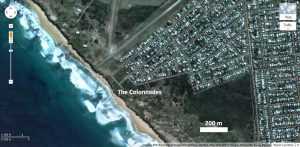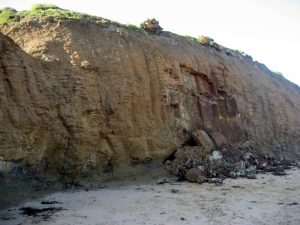
From Phillip Island Rd, at the township of Cape Woolamai, turn into Woolamai Beach Rd and then into Lantana Rd to the right (west) which heads south-west to The Colonnades. There is plenty of parking at the end of the road and you can walk down steps to the beach.

Check the shape and size of the columns. How long are they? Each column represents the depth of one lava flow. Look for remnants of basalt rock and for minerals. Check the alteration products; look for minerals in small pieces of rock.
Significance
These deposits illustrate the extent of the volcanic eruptions and the thickness of each lava flow. You can also see something of the alteration that has occurred on the basalt after it was deposited, producing the pale, soft material as well as rich red and brown soil.
Guide available as a booklet
This entry is taken from the geological excursion guide for Phillip Island. The complete guide is available as a booklet on creation.com Aussie store.